 
 

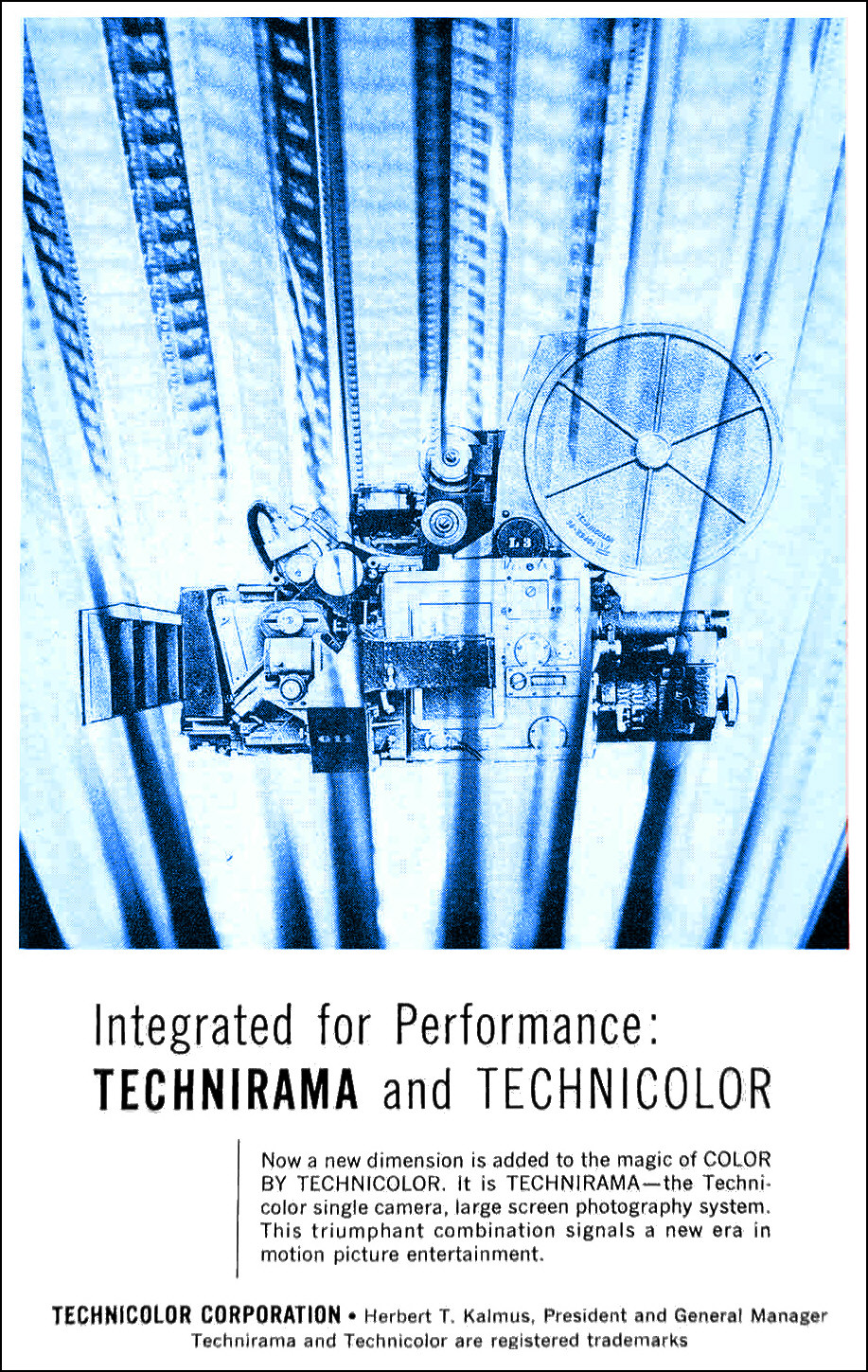 |
1957 trade journal ad
In the early 1950's Technicolor Corp. did
research work with the Old Delft company in Holland on anamorphic projection
attachments for CinemaScope. Delft's "Delrama" anamorphic systems used two
curved mirrors or prisms rather than cylindrical lenses. This work led to
the development of the Technirama Delrama 1.5x anamorphic camera adapter.
Technicolor mated these squeeze adapters to 3-strip cameras that had been
converted to VistaVision. The resulting Technirama frame was very similar to
VistaVision except that Technirama ever so slightly lowered the top of the aperture to create an
aspect ratio of 2.35:1 and this left room for an optical soundtrack when printed
directly to 35mm 8-perf film.

The Monte Carlo Story, a light comedy produced in, where else?, Monte Carlo, by the Italian Titanus company and one of the few they made in English, was the premiere production using Technirama. It opened in Italy in 1956 using 8-perf horizontal projection, as described below. The film reached U.S. shores in 1957. While being a largely unknown film to most people, it is a very amusing, warm comedy that makes the most of its excellent cast and Technirama, under the direction of Guiseppe Rotuno, A.I.C., A.S.C., makes Monte Carlo look like a gem on the Mediterranean Sea. The Curator recommends this film to those who have not seen it.
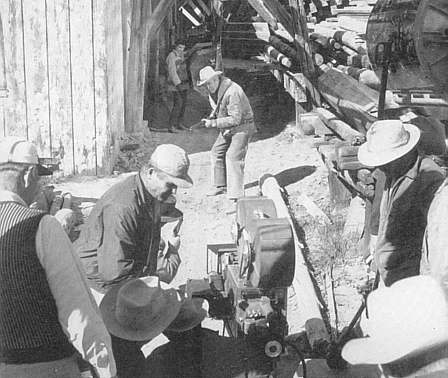 | 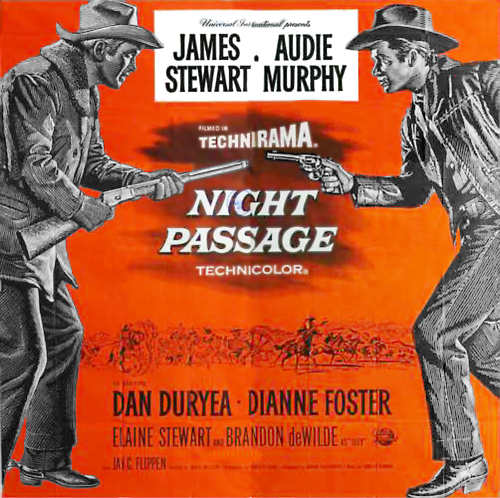 |
(Above left) James Stewart shoots a bad guy while Technirama shoot James Stewart. The converted 3-strip cameras now ran single strip Eastmancolor negative horizontally. The first U.S. production, following The Monte Carlo Story, was
Night Passage produced by Universal-International in 1957. The Director of Photography was
William Daniels, ASC. That name may ring a bell with film buffs. It was Daniels who photographed virtually all of Greta Garbo's American films. The poster's nothing much to get excited about.
|
Frames from the U.S. Technirama debut in a somewhat less than memorable film, a trait shared by a number of the major wide screen systems. James Stewart is featured singing and playing the accordion, but Congressional Medal of Honor winner Audie Murphy actually turned in the best performance in this picturesque horse opera.
The first Technirama production
was The Monte Carlo Story produced in Europe in 1957.
In its initial
European release, this film was printed as an 8-perf double frame print.
Special Delrama attachments with the same 1.5x anamorphic ratio were used in
projection. Other early Technirama films may have seen 8-perf presentation in
Europe but sources at Technicolor-Burbank know of no horizontal Technirama
showings in North America.
|
Technirama Process Debuts In Italy
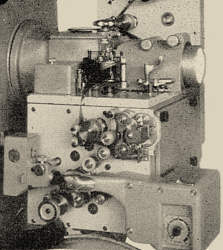
Technirama Sound Head |
IN ORDER to reduce negative grain and provide perfect definition both horizontally and vertically without distortion, the Technicolor Corporation has devised the new Technirama system for its color prints. Expressly designed for the projection of Technirama prints is the new Micronlambda projector manufactured in Turin by the makers of the well-known Microtecnica line of cinema apparatus.
Interesting to projectionists is the combination of Paramount's "lazy-8" 35mm wide-frame system of photography (VistaVision) and the 20th Century-Fox anamorphic process (CinemaScope) inherent in Technirama. The film not only passes horizontally through camera and projector in the Technirama process, but is also compressed in photography and expanded in projection by anamorphic lenses. Instead of an expansion factor of 2, however, as in CinemaScope and Superscope, a factor of 11/2 is employed for better image definition and reduced distortion.
The new Micronlambda projector for Technirama employs a projection aperture having the dimensions 36.11 mm X 22.38 mm (1.421" X 0.818"), providing nearly 800 square millimeters of area. This is the same as the VistaVision "lazy 8" aperture, except for the decreased picture height of Technirama to accommodate the sound track. It amounts to twice the area of the standard 35-mm soundfilm aperture, with a corresponding decrease of negative grain or dye blur in imbibition prints. With an anamorphic expansion factor of 11/2, this aperture gives an aspect ratio of 1.614 X 1.5 = 2.4, very nearly.
New Intermittent Mechanism
Unlike the modified Century projector for horizontal VistaVision prints, the Micronlambda mechanism has been completely redesigned to eliminate all flaws that might conceivably be caused by 35-mm film running horizontally with an 8-hole pulldown by the intermittent sprocket. This included a whole new geneva intermittent mechanism, shutter system., and film path with specially designed sprockets and idlers.
The optical system, also, has been designed with the requirements of the large Technirama film frame in mind. Special "fast" lenses having wide-field characteristics for sharp corner-to-corner focus are used in conjunction with mirror anamorphics of the Delrama type. It is claimed that definition with mirror anamorphics is superior to that obtained with lens-type anamorphics. Obviously, mirror anamorphics are free from chromatic and certain other aberrations afflicting cylindrical lenses.
The first Technirama film production, "Monte Carlo," stars Marlene Dietrich and Vittorio de Sica. It had its world premiere at one of the largest Italian cinemas, the 3000-seat Reposi Theatre in Turin. It is reported that technicians attending this showing were favorably impressed by the clarity and brilliance of the picture projected upon the 21 X 8.75 meters (68.9 feet X 28.7 ft.) Technirama screen. Reprinted from "International Projectionist"
May 1957
Courtesy of David Johnson |
One unique feature of the 8 perf system was the anamorphic projection lens which did not expand the film frame 1.5x times but rather squeezed it down vertically by a factor of 1.5:1. The 8-perf frame allowed for adequate image width without expansion, so the height was reduced to restore the correct 2.35:1 aspect ratio.
As stated above, Technirama used the same
cameras and a very similar aperture size as VistaVision, but its use of the
available camera negative was much more efficient and the available image on
the print was approximately 30% greater, yielding a far sharper image than any
other 35mm based system. In addition to the high quality optics and large
negative and positive images, Technicolor also created a unique development
process for the camera negative. The bleach step created sharper edge areas
than that normally found with the standard Eastmancolor development soup. 35mm
anamorphic prints with standard optical or 4-track magoptical sound were made
using the company's legendary imbibition dye-transfer printing system.
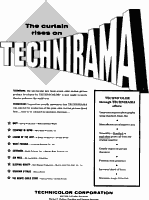 A full page ad from the March, 1957 issue of American Cinematographer. If you find it hard to read then click on the page for a closer look.
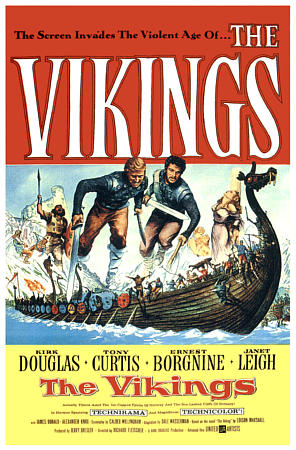 Executive producer/star Kirk Douglas hauled the Technirama cameras to the Norwegian fjords to photograph The Vikings , directed by Richard Fleischer in 1958. The film is pure action-adventure and an absolute blast to watch Douglas, Tony Curtis, and Ernest Borgnine chew the scenery and everything else in sight, including Janet Leigh. The Jack Cardiff photography was stunning, which is an adjective that could be applied to virtually all Technirama films, good or bad, or for any film shot by Jack Cardiff. Good guy Tony Curtis kills bad guy Kirk Douglas in the end. Douglas would settle the score a couple years later in his Technirama production of Spartacus.
Poster courtesy of The Setnik Collection
Mindless violence! Sex! Superb photography! It had 'em all.
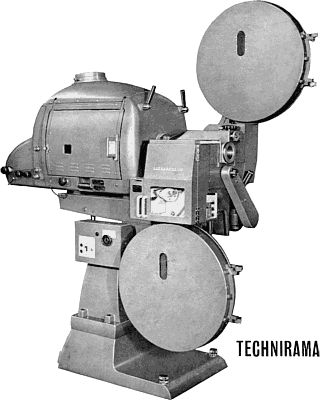
In addition to Microlambda, Britain's Gaumont-Kalee produced an 8-perf horizontal Technirama projector. Essentially the same as their 8-perf VistaVision projector, it included the necessary Technirama anamorphic optics and both optical and magnetic sound capabilities. But neither 8-perf Technirama nor 8-perf VistaVision were widely accepted and Kalee's investment in the development of an 8-perf projector had devastating financial impact on the company.
Seen below is a Technicolor publicity still taken of Tony Curtis and Ernest Borgnine in the beards they grew for Bryna Production's (AKA Kirk Douglas) The Vikings. This display of the new Technirama process was made in London on June 1, 1957, over a year before The Vikings would finally hit the screen. Despite being demonstrated with an 8-perforation horizontal print using the Kalee projector, this method of presentation was used only for the intial presentation of the first feature film, The Monte Carlo Story, in Italy in December, 1956. Technirama would be limited to CinemaScope compatible anamorphic reduction prints only until 1959 with the advent of the Todd-AO compatible 70mm optical prints in 1959.
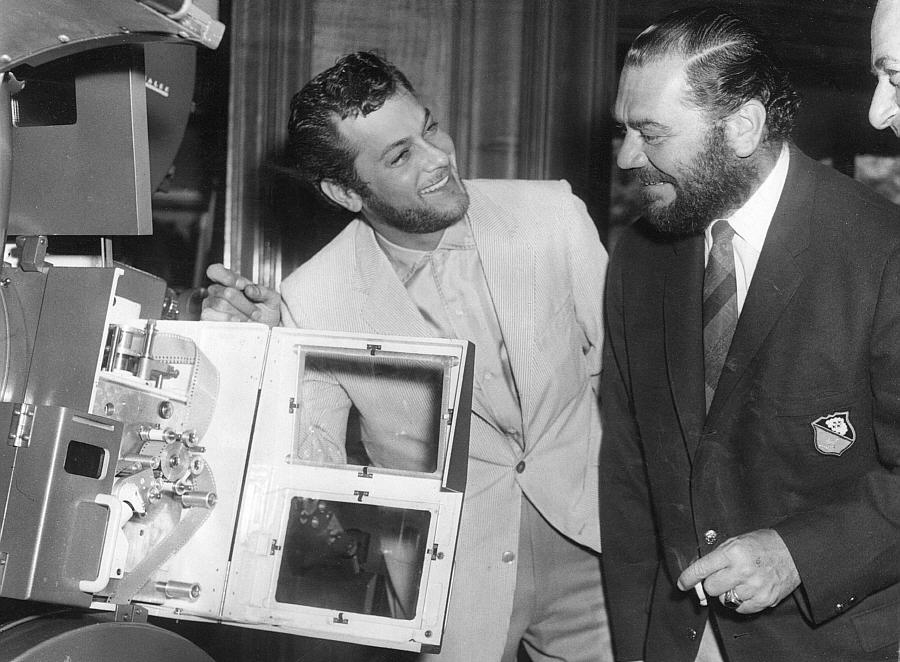
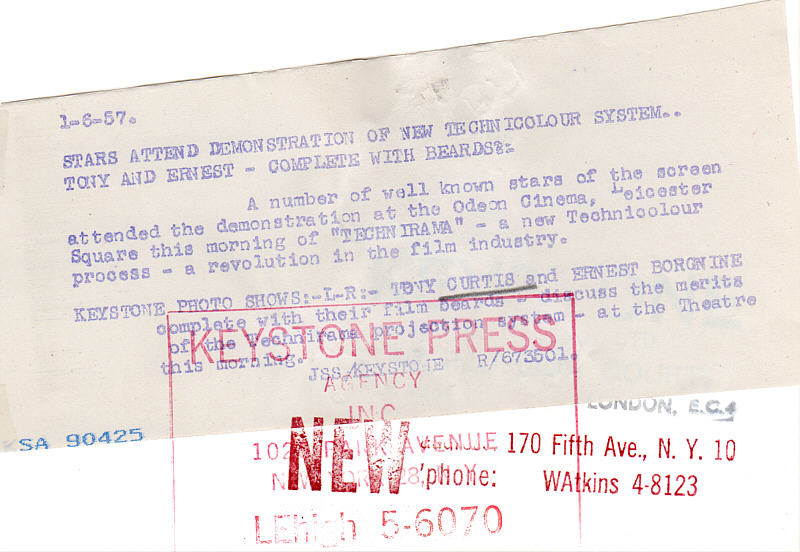
When will the Brits learn to spell TECHNICOLOR? Whoever typed the blurb on the back of the Technirama publicity still didn't realize that. Even if you use the British version of "colour", it's still Technicolor.
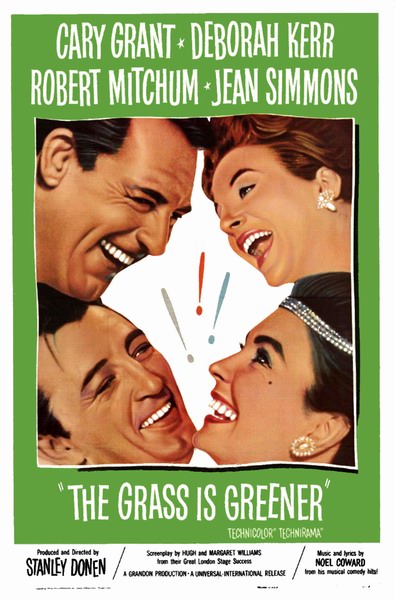 |
Though Technirama proved to be a tremendous asset to outdoor epics, it was not limited to that genre. Producer-director Stanley Donen's 1960 bedroom farce The Grass is Greener is an example. But even here, the bedrooms were in Cary Grant's castle in the English countryside. Deborah Kerr, had always looked great in Technicolor and the high definition image presented by Technirama further proved how attractive she was. Director Donen took advantage of Technirama's image quality by frequently using multiple screens to cover the action. Co-star Jean Simmons might qualify as having appeared in more Technirama pictures than any other major female lead. |
One of several variations on VistaVision and Technirama 8-perforation horizontal 35mm
cameras. This is referred to as a Butterfly camera. Can you guess why, boys and girls?
|
You are on Page 1 of 
      
©1997 - 2013 The American WideScreen Museum
http://www.widescreenmuseum.com
Martin Hart, Curator |















